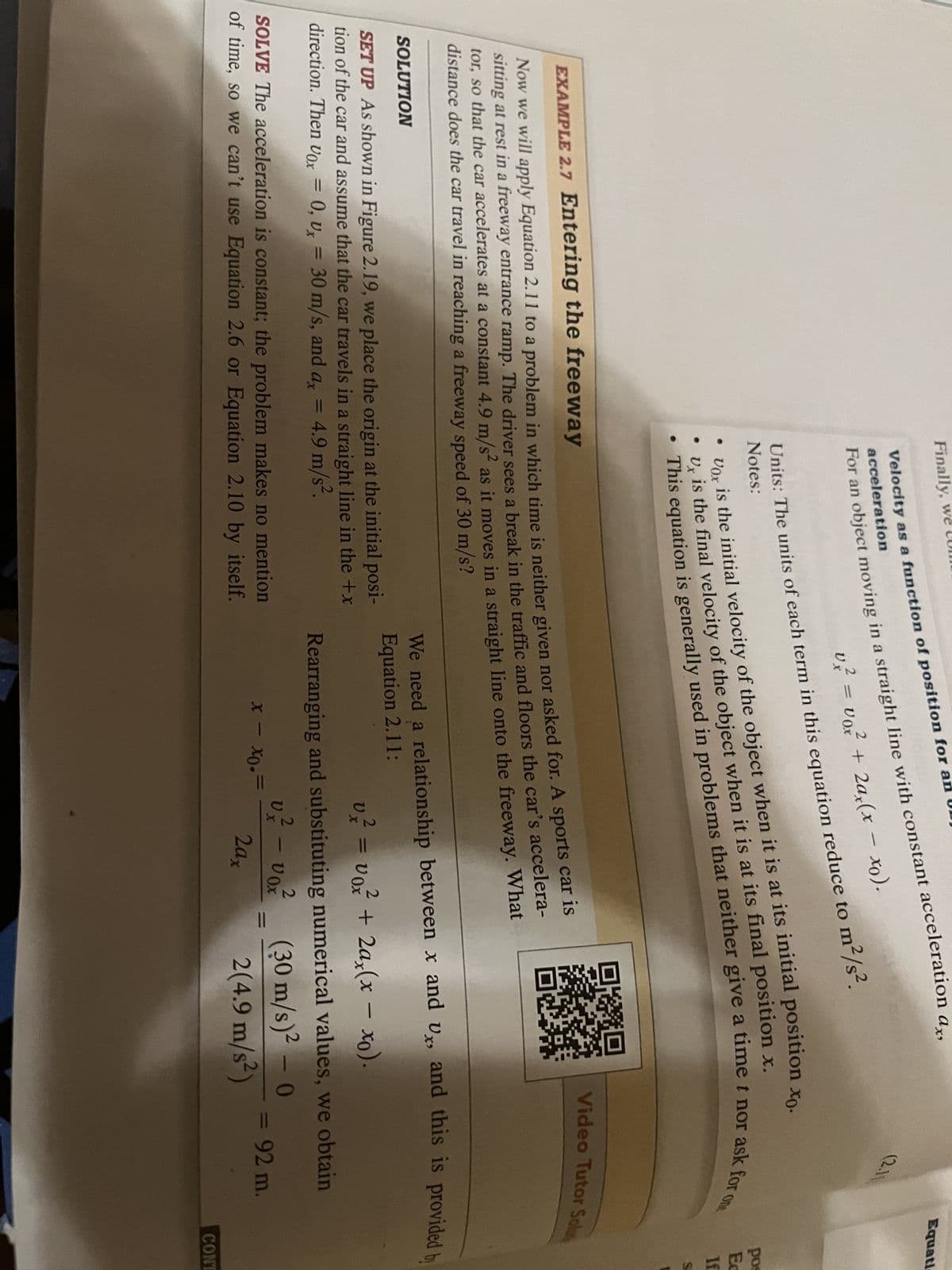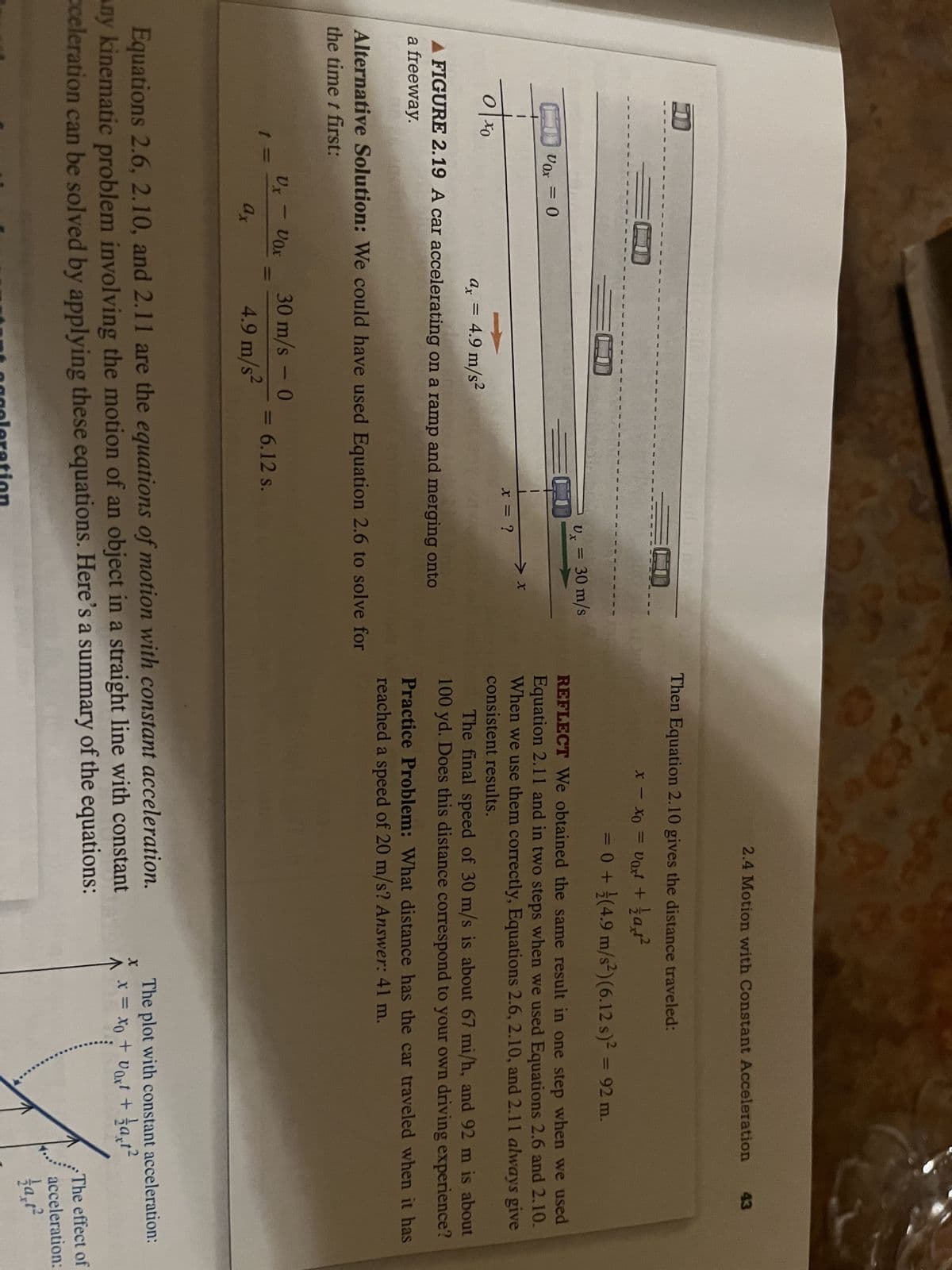Chapter6: Waves And Sound
Section: Chapter Questions
Problem 9C
Related questions
Question
(I just need the practice problem worked out. The other picture has the background info needed to solve the answer. The correct answer is also provided to be able to check work.)

Transcribed Image Text:Finally, we
Velocity as a function of position for an
acceleration
For an object moving in a straight line with constant acceleration ax,
-
2
2
v² = voz² + 2ax(x − xo).
Ux
Units: The units of each term in this equation reduce to m²/s².
Notes:
is the initial velocity of the object when it is at its initial position xo.
•
Vox
• Ux
This equation is generally used in problems that neither give a time t nor ask for o
U is the final velocity of the object when it is at its final position x.
EXAMPLE 2.7 Entering the freeway
is
Now we will apply Equation 2.11 to a problem in which time is neither given nor asked for. A sports car
sitting at rest in a freeway entrance ramp. The driver sees a break in the traffic and floors the car's accelera-
tor, so that the car accelerates at a constant 4.9 m/s² as it moves in a straight line onto the freeway. What
distance does the car travel in reaching a freeway speed of 30 m/s?
SOLUTION
SET UP As shown in Figure 2.19, we place the origin at the initial posi-
tion of the car and assume that the car travels in a straight line in the +x
direction. Then Vox = 0, Ux = 30 m/s, and ax 4.9 m/s².
SOLVE The acceleration is constant; the problem makes no mention
of time, so we can't use Equation 2.6 or Equation 2.10 by itself.
2
2
V
v² = v₁² + 2ax(x − xo).
x - xo.
We need a relationship between x and Ux, and this is provided by
Equation 2.11:
Rearranging and substituting numerical values, we obtain
(30 m/s)² - 0
2(4.9 m/s²)
V
2
X
-
2
VOX
(2.11
2ax
=
Video Tutor Solut
=
Equati
pos
Ec
If
S
92 m.
CONT

Transcribed Image Text:Vox = 0
t =
Ux
D
-
otxo
ax = 4.9 m/s²
A FIGURE 2.19 A car accelerating on a ramp and merging onto
a freeway.
ax
Alternative Solution: We could have used Equation 2.6 to solve for
the time t first:
VOX
x = ?
30 m/s-0
4.9 m/s²
6
Ux = 30 m/s
= 6.12 s.
X
t acceleration
e
A
2.4 Motion with Constant Acceleration 43
Then Equation 2.10 gives the distance traveled:
x = xo = Voxt + a₂²
-
хо
= 0 + (4.9 m/s²) (6.12 s)² = 92 m.
REFLECT We obtained the same result in one step when we used
Equation 2.11 and in two steps when we used Equations 2.6 and 2.10.
When we use them correctly, Equations 2.6, 2.10, and 2.11 always give
consistent results.
The final speed of 30 m/s is about 67 mi/h, and 92 m is about
100 yd. Does this distance correspond to your own driving experience?
Practice Problem: What distance has the car traveled when it has
reached a speed of 20 m/s? Answer: 41 m.
Equations 2.6, 2.10, and 2.11 are the equations of motion with constant acceleration.
any kinematic problem involving the motion of an object in a straight line with constant
cceleration can be solved by applying these equations. Here's a summary of the equations:
The plot with constant acceleration:
^ x = xo + vaxt + a 1²
The effect of
acceleration:
a,t²
Expert Solution
This question has been solved!
Explore an expertly crafted, step-by-step solution for a thorough understanding of key concepts.
This is a popular solution!
Trending now
This is a popular solution!
Step by step
Solved in 3 steps

Knowledge Booster
Learn more about
Need a deep-dive on the concept behind this application? Look no further. Learn more about this topic, physics and related others by exploring similar questions and additional content below.Recommended textbooks for you


University Physics Volume 1
Physics
ISBN:
9781938168277
Author:
William Moebs, Samuel J. Ling, Jeff Sanny
Publisher:
OpenStax - Rice University

Classical Dynamics of Particles and Systems
Physics
ISBN:
9780534408961
Author:
Stephen T. Thornton, Jerry B. Marion
Publisher:
Cengage Learning


University Physics Volume 1
Physics
ISBN:
9781938168277
Author:
William Moebs, Samuel J. Ling, Jeff Sanny
Publisher:
OpenStax - Rice University

Classical Dynamics of Particles and Systems
Physics
ISBN:
9780534408961
Author:
Stephen T. Thornton, Jerry B. Marion
Publisher:
Cengage Learning